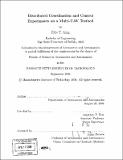| dc.contributor.advisor | Jonathan P. How. | en_US |
| dc.contributor.author | King, Ellis T. (Ellis Taylor), 1979- | en_US |
| dc.contributor.other | Massachusetts Institute of Technology. Dept. of Aeronautics and Astronautics. | en_US |
| dc.date.accessioned | 2005-09-27T18:55:19Z | |
| dc.date.available | 2005-09-27T18:55:19Z | |
| dc.date.copyright | 2004 | en_US |
| dc.date.issued | 2004 | en_US |
| dc.identifier.uri | http://hdl.handle.net/1721.1/28894 | |
| dc.description | Thesis (S.M.)--Massachusetts Institute of Technology, Dept. of Aeronautics and Astronautics, 2004. | en_US |
| dc.description | Includes bibliographical references (p. 153-157). | en_US |
| dc.description.abstract | (cont.) of environmental disturbances and measurement noise.The product of this thesis is a robust planning system that is tolerant of the types of uncertainty experienced by real aircraft. This robustness has been demonstrated by more than 20 successful flights on a fully automated UAV testbed. | en_US |
| dc.description.abstract | This thesis presents the development and testing of a unique testbed consisting of a fleet of eight unmanned aerial vehicles (UAVs) that was designed as a platform for evaluating coordination and control algorithms. A hierarchical configuration of task assignment, trajectory design, and low-level, waypoint following, are used in a receding horizon framework to control the UAV system. Future UAV teams will have to autonomously demonstrate cooperative behaviors in dynamic and uncertain environments, and this testbed can be used to compare various control approaches to accomplish these coordinated missions. Flight demonstrations are made utilizing real-time mixed-integer linear programming techniques, exercising the algorithms in realistic environments with real-world disturbances. Large disturbance sources, computational delay and measurementnoise all represent significant error sources that reduce the ability of UAV teams to interact in a coordinated fashion by increasing uncertainty on higher planning levels. This thesis develops a method that explicitly accounts for this uncertainty by including feedback loops on the task assignment and trajectory design algorithms to prescribe added robustness for the uncertainty at each stage. This approach takes into account low level controller saturation limits that might cause infeasibilities in the plans created at the higher levels of the planning system. Detailed and realistic simulation environments are useful for large-scale multi-vehicle simulations, particularly when logistics prevent flight testing on that scale. This thesis validates one such hardware-in-the-loop simulation environment through the comparison of models obtained from experimentally collected flight data and detailed modeling | en_US |
| dc.description.statementofresponsibility | by Ellis T. King. | en_US |
| dc.format.extent | 157 p. | en_US |
| dc.format.extent | 8011522 bytes | |
| dc.format.extent | 8032735 bytes | |
| dc.format.mimetype | application/pdf | |
| dc.format.mimetype | application/pdf | |
| dc.language.iso | en_US | |
| dc.publisher | Massachusetts Institute of Technology | en_US |
| dc.rights | M.I.T. theses are protected by copyright. They may be viewed from this source for any purpose, but reproduction or distribution in any format is prohibited without written permission. See provided URL for inquiries about permission. | en_US |
| dc.rights.uri | http://dspace.mit.edu/handle/1721.1/7582 | |
| dc.subject | Aeronautics and Astronautics. | en_US |
| dc.title | Distributed coordination and control experiments on a multi-UAV testbed | en_US |
| dc.type | Thesis | en_US |
| dc.description.degree | S.M. | en_US |
| dc.contributor.department | Massachusetts Institute of Technology. Department of Aeronautics and Astronautics | |
| dc.identifier.oclc | 60457822 | en_US |

